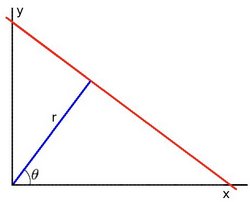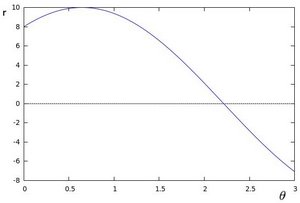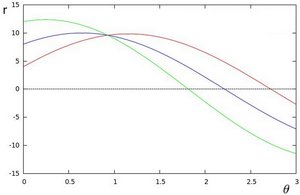- 霍夫线变换是一种用来寻找直线的方法.
- 是用霍夫线变换之前, 首先要对图像进行边缘检测的处理,也即霍夫线变换的直接输入只能是边缘二值图像.
它是如何实现的?
-
众所周知, 一条直线在图像二维空间可由两个变量表示. 例如:
- 在 笛卡尔坐标系: 可由参数:
 斜率和截距表示.
斜率和截距表示. - 在 极坐标系: 可由参数:
 极径和极角表示
极径和极角表示

对于霍夫变换, 我们将用 极坐标系 来表示直线. 因此, 直线的表达式可为:

化简得:

- 在 笛卡尔坐标系: 可由参数:
-
一般来说对于点
 , 我们可以将通过这个点的一族直线统一定义为:
, 我们可以将通过这个点的一族直线统一定义为:
这就意味着每一对
 代表一条通过点
代表一条通过点  的直线.
的直线. -
如果对于一个给定点
 我们在极坐标对极径极角平面绘出所有通过它的直线, 将得到一条正弦曲线. 例如, 对于给定点
我们在极坐标对极径极角平面绘出所有通过它的直线, 将得到一条正弦曲线. 例如, 对于给定点  and
and  我们可以绘出下图 (在平面
我们可以绘出下图 (在平面  -
-  ):
):
只绘出满足下列条件的点
 and
and  .
. -
我们可以对图像中所有的点进行上述操作. 如果两个不同点进行上述操作后得到的曲线在平面
 -
-  相交, 这就意味着它们通过同一条直线. 例如, 接上面的例子我们继续对点:
相交, 这就意味着它们通过同一条直线. 例如, 接上面的例子我们继续对点:  ,
,  和点
和点  ,
,  绘图, 得到下图:
绘图, 得到下图:
这三条曲线在
 -
-  平面相交于点
平面相交于点  , 坐标表示的是参数对 (
, 坐标表示的是参数对 ( ) 或者是说点
) 或者是说点  , 点
, 点  和点
和点  组成的平面内的的直线.
组成的平面内的的直线. -
那么以上的材料要说明什么呢? 这意味着一般来说, 一条直线能够通过在平面
 -
-  寻找交于一点的曲线数量来 检测. 越多曲线交于一点也就意味着这个交点表示的直线由更多的点组成. 一般来说我们可以通过设置直线上点的 阈值 来定义多少条曲线交于一点我们才认为 检测 到了一条直线.
寻找交于一点的曲线数量来 检测. 越多曲线交于一点也就意味着这个交点表示的直线由更多的点组成. 一般来说我们可以通过设置直线上点的 阈值 来定义多少条曲线交于一点我们才认为 检测 到了一条直线. -
这就是霍夫线变换要做的. 它追踪图像中每个点对应曲线间的交点. 如果交于一点的曲线的数量超过了 阈值, 那么可以认为这个交点所代表的参数对
 在原图像中为一条直线.
在原图像中为一条直线.
标准霍夫线变换和统计概率霍夫线变换
OpenCV实现了以下两种霍夫线变换:
- 标准霍夫线变换
- 原理在上面的部分已经说明了. 它能给我们提供一组参数对
的集合来表示检测到的直线
- 在OpenCV 中通过函数 HoughLines 来实现
- 统计概率霍夫线变换
- 这是执行起来效率更高的霍夫线变换. 它输出检测到的直线的端点
- 在OpenCV 中它通过函数 HoughLinesP 来实现
//! finds lines in the black-n-white image using the standard or pyramid Hough transform CV_EXPORTS_W void HoughLines( InputArray image, OutputArray lines, double rho, double theta, int threshold, double srn=0, double stn=0 );
- image: 边缘检测的输出图像. 它应该是个灰度图 (但事实上是个二值化图)
- lines: 储存着检测到的直线的参数对
的容器
- rho : 参数极径
以像素值为单位的分辨率. 我们使用 1 像素.
- theta: 参数极角
以弧度为单位的分辨率. 我们使用 1度 (即CV_PI/180)
- threshold: 要”检测” 一条直线所需最少的的曲线交点
- srn and stn: 参数默认为0. 查缺OpenCV参考文献来获取更多信息.
//! finds line segments in the black-n-white image using probabilistic Hough transform CV_EXPORTS_W void HoughLinesP( InputArray image, OutputArray lines, double rho, double theta, int threshold, double minLineLength=0, double maxLineGap=0 );
- image: 边缘检测的输出图像. 它应该是个灰度图 (但事实上是个二值化图)
- lines: 储存着检测到的直线的参数对
的容器
- rho : 参数极径
以像素值为单位的分辨率. 我们使用 1 像素.
- theta: 参数极角
以弧度为单位的分辨率. 我们使用 1度 (即CV_PI/180)
- threshold: 要”检测” 一条直线所需最少的的曲线交点
- minLinLength: 能组成一条直线的最少点的数量. 点数量不足的直线将被抛弃.
- maxLineGap: 能被认为在一条直线上的亮点的最大距离.
//! draws the line segment (pt1, pt2) in the image CV_EXPORTS_W void line(CV_IN_OUT Mat& img, Point pt1, Point pt2, const Scalar& color, int thickness=1, int lineType=8, int shift=0);
Parameters
img Image. pt1 First point of the line segment. pt2 Second point of the line segment. color Line color. thickness Line thickness. lineType Type of the line, see cv::LineTypes. shift Number of fractional bits in the point coordinates.
